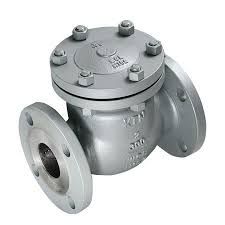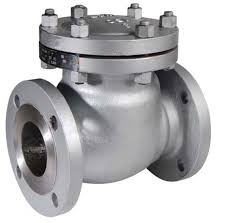Carbon Steel Check Valve Swing Type

The Application of Carbon Steel Check Valve
Carbon steel check valves are versatile and durable, widely used in industrial applications. Carbon Steel Check Valve Specifications include high-temperature and high-pressure resistance, making them suitable for chemical processing and offshore facilities. Heavy-Duty Carbon Steel Check Valves handle harsh environments, while High-Temperature Carbon Steel Check Valves excel in steam systems and heat exchangers. Cameron is a leading brand offering innovative valve solutions for industrial fluid control.
What Are The Types Of Carbon Steel Check Valve?
- Swing Check Valve:
- The most common type of check valve
- Features a hinged disc that swings open to allow flow in one direction and closes to prevent backflow
- Relatively simple and inexpensive design
- Lift Check Valve:
- Has a guided, spring-loaded disc that lifts off its seat to allow flow in one direction
- Provides a tighter shut-off compared to swing check valves
- Often used in applications with high pressure differentials
- Ball Check Valve:
- Uses a ball that rolls on its seat to open and close the valve
- Provides a positive seal and can handle high pressure and velocity applications
- Commonly used in pipelines, pumps, and compressors
- Dual Plate (Wafer) Check Valve:
- Features two hinged plates that open and close to allow and prevent flow
- Compact design that is easy to install between flanges
- Suitable for applications with limited space
- Tilting Disc Check Valve:
- Has a disc that tilts open to allow flow in one direction
- Offers a more stable and controlled opening and closing compared to swing check valves
- Used in applications with high pressure or flow velocities
What Is Carbon Steel Check Valve?
A carbon steel check valve is a type of valve used in piping systems to allow fluid flow in one direction while preventing backflow. It is a self-actuating valve that opens when the fluid pressure overcomes the valve’s spring or gravity, and closes automatically when the flow reverses. Carbon steel is a common material used for check valves due to its strength, durability, and corrosion resistance. These valves are often found in industrial applications, such as water distribution, HVAC systems, oil and gas pipelines, and chemical processing plants, where they play a crucial role in maintaining the integrity and safety of the system.
How to Select the Right Carbon Steel Check Valve?
Pressure and Temperature Ratings: Ensure the valve is rated for the maximum pressure and temperature of the system. Higher pressure and temperature requirements may call for a different valve type, such as a lift check or ball check.
Flow Rate and Velocity: Determine the expected flow rate and velocity to ensure the valve can handle the necessary capacity without excessive pressure drop.
Pipe Size and Connection Type: Match the valve size and connection type (e.g., flanged, threaded, or socket-welded) to the pipe size and fittings in the system.
Material Compatibility: Verify that the carbon steel valve material is compatible with the fluids flowing through the system to prevent corrosion or chemical attack.
Installation Requirements: Consider the available space and orientation requirements for the valve, as well as any necessary accessories like strainers or isolation valves.
By carefully evaluating these factors, you can select the most appropriate carbon steel check valve for your specific application, ensuring reliable and efficient operation.
Features of Carbon Steel Check Valve
Strength and Durability: Carbon steel is known for its high strength, making carbon steel check valves suitable for demanding applications with high pressure and temperature requirements.
Corrosion Resistance: The inherent corrosion resistance of carbon steel allows these valves to withstand exposure to a wide range of fluids and operating environments.Versatility: Carbon steel check valves are available in a variety of designs, such as swing, lift, ball, and tilting disc, allowing for selection based on specific application needs.Cost-Effectiveness: Compared to other materials like stainless steel, carbon steel is generally more cost-effective, making carbon steel check valves a popular choice for many industrial applications.Ease of Maintenance: The simple design of many carbon steel check valves facilitates easy inspection, maintenance, and replacement when necessary.Reliable Operation: The self-actuating nature of carbon steel check valves ensures reliable flow control and backflow prevention, contributing to the overall system safety and efficiency.
Advantages and Disadvantages of Carbon Steel Check Valve
Advantages:
Strength and Durability: Carbon steel is a robust material that can withstand high pressures and temperatures, making carbon steel check valves suitable for demanding applications.
Corrosion Resistance: The inherent corrosion resistance of carbon steel allows these valves to operate in a wide range of environments without significant degradation.
Cost-Effectiveness: Compared to other materials like stainless steel, carbon steel is generally more affordable, making carbon steel check valves a cost-effective solution.
Ease of Maintenance: The simple design of many carbon steel check valves facilitates easy inspection, maintenance, and replacement when necessary.
Disadvantages:
Limited Chemical Resistance: While carbon steel has good corrosion resistance, it may not be suitable for applications involving highly corrosive or chemically aggressive fluids.
Susceptibility to Rust: Carbon steel can be prone to rusting and oxidation, especially in moist or humid environments, which can compromise the valve’s performance over time.
Lower Thermal Conductivity: Compared to some other materials, carbon steel has lower thermal conductivity, which may limit its use in applications with strict temperature requirements.
Potential for Contamination: The use of carbon steel in check valves can lead to potential contamination of the fluid system due to the release of metal particles or corrosion byproducts.

The Specifications of Carbon Steel Check Valve
| Specification | Details |
|---|---|
| Type | Swing Check Valve |
| Ball Material | Carbon Steel |
| Attachment Type | Flanged |
| Thread Standard | ANSI B16.5 |
| Thread Size | 2 inch |
| Body Material | Carbon Steel |
| Safe for Use With | Water, Oil, Gas, Steam |
| Handle Type | Handwheel |
| Handle Material | Carbon Steel |
| Maximum Working Pressure (psi) | 150 |
| Maximum Working Pressure (bar) | 10 |
| Operating Pressure | 10-120 psi |
The Installation Steps for Carbon Steel Check Valve
- Inspect the Valve: Thoroughly inspect the carbon steel check valve to ensure there is no damage or defects that could affect its performance.
- Prepare the Pipe: Clean and prepare the pipe where the check valve will be installed. Remove any debris, burrs, or obstructions to ensure a smooth installation.
- Determine the Flow Direction: Identify the flow direction and position the check valve accordingly, with the arrow on the valve body pointing in the direction of the intended flow.
- Install Isolation Valves: If necessary, install isolation valves upstream and downstream of the check valve to allow for easy maintenance and servicing.
- Secure the Valve: For flanged connections, align the check valve’s flanges with the mating pipe flanges and use the appropriate bolts and gaskets to secure the valve in place.
- Tighten the Connections: Evenly tighten the flange bolts or thread the valve into the pipe, ensuring a tight and leak-free seal.
- Perform Leakage Tests: Once the valve is installed, conduct a leakage test to ensure the connections are tight and the valve is functioning properly.
- Insulate the Valve (if required): If the application requires thermal insulation, install the appropriate insulation materials around the check valve to maintain the desired temperature.
- Verify Operation: Carefully open and close the upstream and downstream isolation valves to confirm the check valve is operating smoothly and providing the desired flow control.
- Document the Installation: Record the installation details, including the valve’s location, orientation, and any relevant maintenance information for future reference.
The Operation Theory of Carbon Steel Check Valve
Operation Theory of Carbon Steel Check Valves:
- Pressure-Actuated Design: Carbon steel check valves operate on the principle of pressure differential. When the fluid flow is in the forward direction, the pressure pushes the valve open, allowing the fluid to pass through.
- Gravity-Assisted Closing: When the flow reverses, the weight of the valve’s internal components (such as the swing disc or ball) causes the valve to close, preventing backflow and ensuring one-way fluid movement.
- Self-Actuating Mechanism: The design of carbon steel check valves is inherently self-actuating, meaning they do not require any external power source or control system to open and close the valve.
Chemical Pipeline Carbon Steel Check Valves:
- Corrosion Resistance: The carbon steel material used in these valves exhibits good corrosion resistance, making them suitable for use in chemical pipelines handling a wide range of fluids, including acids, bases, and other corrosive chemicals.
- High Pressure Ratings: Carbon steel check valves can be designed to withstand the high pressures commonly found in chemical processing facilities, ensuring reliable performance.
- Temperature Tolerance: The robustness of carbon steel allows these valves to operate effectively in environments with elevated temperatures, common in many chemical processing applications.
Marine Carbon Steel Check Valves:
- Saltwater Compatibility: The corrosion-resistant properties of carbon steel make these valves well-suited for use in marine environments, where they can withstand exposure to saltwater and other corrosive elements.
- Mechanical Strength: The inherent strength of carbon steel enables these valves to withstand the physical stresses and vibrations encountered in marine applications, such as on ships and offshore platforms.
- Easy Maintenance: The simple design of carbon steel check valves simplifies maintenance and inspection, ensuring reliable operation in the demanding marine environment.
